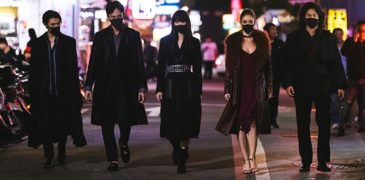
“Southold, New York, 1843: Young Mary (Stefanie Scott), blood trickling from behind the blindfold tied around her eyes, is interrogated about the events surrounding her grandmother’s death. As the story jumps back in time, we witness Mary, raised in a repressively religious household, finding fleeting happiness in the arms of Eleanor (Isabelle Fuhrman), the home’s maid. Her family, who believe they are seeing, speaking, and acting on God’s behalf, view the girls’ relationship as an abomination, to be dealt with as severely as possible. The couple attempt to carry on in secret, but someone is always watching, or listening, and the wages of perceived sin threaten to become death, with the tension only heightened by the arrival of an enigmatic stranger (Rory Culkin) and the revelation of greater forces at work.” (Official Synopsis)

Steeped in religious prosecution, “The Last Thing Mary Saw” thrives on its ability to create a wholly immersive environment. For a debut director, Edoardo Vitaletti impresses with his command of bringing the world of Mary to life in a frightening manner. This is commendably achieved in one of two ways primarily.
The environment and seclusion of the family exists in a world unto its own. Additionally, the cinematography and sound design always remind the viewer of the remote existence tied to a strict religious code of how to run a household. As such, there is a constant sense of unease as the two young lovers feel trapped by family, morality and location. Every creek in the house, or hidden candlelight, gives the impression of a persecuted existence – more terrifying than any of the more overt supernatural elements.
The performances, particularly that of matriarch Judith Roberts and Stefanie Scott, encapsulate the conflicting old and new traditions, as well as the struggle between ‘good vs evil’ duality. Roberts is a daunting figure who is stern and unforgiving, while Scott portrays a determined innocence looking for freedom. A disturbing contrast, it is handled brilliantly through both performances. There is also a brief role from Rory Culkin that truly achieves a strong impact that bleeds brilliantly into the conclusion.

Posing questions of morality, the focus on the religious prosecution of forbidden love is an intriguing premise to build the story around. However, speaking to the legitimacy of how this is approached is not something this review can comment on with any definitive authority. As a layman, It feels grounded and plausible, indeed, but some of the dialogue feels contrived and inauthentic. Regardless, it is deeply engrossing and the audience’s perception of authenticity is certain to lead to an interesting discussion on the predominant religious themes defining The Last Thing Mary Saw.
The ‘slow burn’ approach to horror is one that holds appeal to many modern-day fans, and while The Last Thing Mary Saw is certainly that, it does struggle with pacing overall. Furthermore, the supernatural aspects are downplayed and unreliable, causing the production to certainly test patience. Atmosphere building is more important than horror, however, those who enjoyed other recent new Shudder titles, like The Advent Calendar or Martyr’s Lane, will find the film the perfect compliment in flow and content.
Undeniably, the appeal of The Last Thing Mary Saw will be limited in its nuanced approach, but this affords an incisive focus sure to resonate to those seeking a captivating experience. The themes of religion, though competently portrayed, lacks the sensationalism that is needed to successfully orchestrate a lasting mark. However, the script, performances, and worldbuilding make the film a stand-out worthy of exploration – just approach with patience and immerse yourself in the world Edoardo Vitaletti has crafted.
The Last Things Marry Saw is a Shudder Original. It is set to arrive on DVD and digital on 19 September 2022 from Acorn Media International.

More From Shudder
Offseason opens with grainy, nostalgic footage of beach holidays, set to a fairy tale musical score, before cutting sharply to a grey, desolate coastal shot, where cold waters meet unwelcoming… Many look to the upper echelons of society with a peculiar sense of awe, lives where money is no longer a concern is something that has drawn people into these… Shudder, as a platform for exclusive releases, has been an enjoyable and interesting experience. Being able to curate directly for fans of the genre has allowed an impressive range of… 2020 has been a turbulent year, with many productions being delayed into 2021, or outright canceled. However, that did not stop some great films from coming out in 2020. Here… Selected to cap off the closing night of Fright Fest 2021, The Advent Calendar has come to the attention of horror fans as one of the titles already announced as… Despite the belief that this humble viewer may have been drawn in by such a provocative title, Porno, (also cringingly known as Fangoria’s Porno) premise was enough to pique my interest….Offseason (2022) Film Review: Wish We Weren’t Here
Dead and Beautiful (2021) Film Review – The Decadent Undead
Mosquito State (2020) Film Review – A Muddled Metaphorical Treatise on Bloodsuckers
The Grimoire of Horror Presents: The Best Films of 2020
The Advent Calendar Film Review – Eat Chocolate or Die!
Porno (2020) Review: Not Actually Porno…





